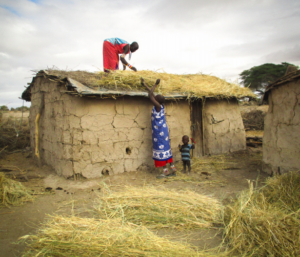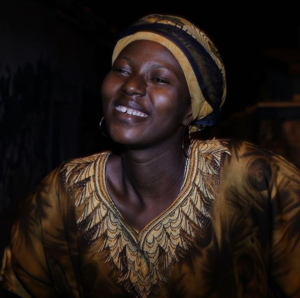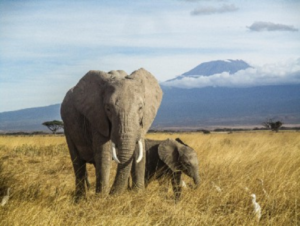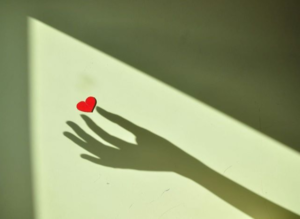The Personal is Political, an Interview with Lensational
Lensational is a youth-and-women-led global movement that trains women in under-represented communities in photography, digital storytelling, and video production. In partnership with local organisations, they provide women with photographic mentorship and ongoing support and through exhibitions and panel events help to promote and amplify their work and provide viewers the opportunity to experience the world through their lens. The photography is sold on the Lensational platform with 50% of the revenue directly going to the photographer and 50% reinvested in their programmes.
We were inspired by Lensational’s commitment to empowering women to share their stories and advocate for the issues they face, so we sat down with Founder, Bonnie Chiu, Head of Communications, Lucile Stengel, and Head of Global Programmes, Lydia Wanjiku, to find out more about their work for our Representation Matters series.
In your mission statement, you explain that ‘Each image acts as a mirror against which we can reflect and question our perceived self, giving insights into the mechanics of our inner world. At the same time, photography triggers an awareness of the existence of alternative, intangible realms. Overall, it can establish a portrait of both, what we are looking at and more importantly, of how we look at things’.
The statement highlights the politics of both framing and seeing that are implicit in photography as both a practice and medium. I wonder if you could speak a little on how you understand this dual function of photography.
Bonnie: When we first started, we took a feminist view of the world and followed the notion that the personal is political. We were deeply inspired by Susan Sontag’s writing and the idea that a photographer uses their practice to both reflect on themselves and the wider world. Our initial slogan was ‘empowering women through photography’ and we were particularly interested in the proliferation of self-portraits in the work of female photographers who felt a need to represent themselves, to see themselves in a world that doesn’t often see them. We spent a lot of time thinking about the importance of controlling your own narrative and curating your own mirror on the world.
But as we continued our work, our ideology and methodology shifted and we began to take a more expansive approach to photography as both a practice and medium. We moved beyond thinking of photography as a self-driven form of reflection and started to think of photography as a universal language. An image incurs a new meaning every time it is shown depending on who sees it and this is, in part, informed by the frame or gaze that is offered within the image itself.
For example, in our exhibition Unfurling Bangladesh at Rich Mix, we contacted a local community group that works with Bangladeshi women and invited them to attend- the feedback was incredible. The women described how reflective the images were of their lives back in Bangladesh and how the exhibition provided a powerful diasporic connection- a portal to travel back to a different time and space. I suspect that this profound connection with the images was born from the different gaze and frame offered by the Bangladeshi photographers.
Absolutely. I wonder if we could unpack this word, gaze, a little more. In your mission statement you talk about how women are often framed by the ‘dominant male gaze’ but for those less familiar with this kind of terminology and theory, could you explain what the male gaze is and how it functions in popular or common representations of women?
Lucile: It was through interrogating the power of the gaze that provided the starting point for lensational, but it’s not just the dominant male gaze, it’s the dominant western gaze and it’s the dominant white gaze. Photography is always an objectifying process, as the subject of a photograph you become the subject of whoever portrays you and the lens of their gaze.
The issue for us is that the large majority of the photographers and a large majority of the gazes through which we discover the world come from the same geographical place, the same gender and belong to the same class. The uniformity of perspectives raises an important question about who is behind the camera and what preconceived ideas they are bringing with them about the subject and what gaze is informing the framing of the subject. Or put more simply, how does the subject get objectified by that person behind the camera?
If the overwhelming majority of photographers, especially photojournalists, are male and come from the West, we should be critical of how diverse and representative the images we view are. That’s what was different about the exhibition at Rich Mix. People that came from the Bangladeshi community resonated with the images because they were produced by people with a cultural link. It was this different gaze that they connected with. The success of this exhibition inspired us to continue our mission to bring more diversity to photography- diverse gazes captured by different people behind the camera.
Absolutely, the person behind the camera may be unseen but they are written within the image. It’s their field of vision that is offered and their particular way of framing that is produced. I think that’s an aspect of photography that can often go unrecognised or rather uninterrogated. Photographs are often accepted as visual evidence, but photographs aren’t facts, they are ways of framing. Implicit within those frames too are power dynamics and it is those dynamics that need to be both recognised and confronted.
I would be really interested to hear your thoughts on the power dynamics specifically within global health / development imagery. What power dynamics do you see at play there?
Bonnie: Lensational has gained quite a bit of traction with media outlets and corporates, but we’ve never sold an image to the development sector. The brutal truth is that those empowering images don’t sell in this Global North – Global South, rich-people-donating-to-poor-people context. While the development sector declares that ‘we need to change the narrative’ the brutal truth is that empowering images just don’t sell, they don’t incur as many donations in the way that something that sensationalises their cause does. I think things are changing slowly and they are making incremental improvements, but the fact that lensational has been unable to sell an image to the development sector in seven years is a testament to the pace of change.
Lucile: There’s also a massive issue of who works in the development sector as well. I’ve seen the process of selecting images, you go on Getty, you search a keyword and that’s it, there’s no thought to who is the photographer, what community are they from, what’s their story? There’s no thought given to those power dynamics within the photograph. The process for selecting images for advertising and reports that exists within most organisations isn’t considered as important as the other work, it’s more of an after-thought.
Bonnie: Exactly and this is a problem. In a study conducted by Getty Images and Save the Children, they contacted the subjects of the most successful image-based fundraising campaigns – the photographs that made the most money for the cause- and spoke to them about how they felt about being used to make so much money. Many of the people interviewed felt that the depiction of themselves was not dignified and explained that they had no real communication with either the organisation or the photographer so had no idea what the image was going to be used for. This is an ethical challenge. That’s why it’s so important to have ongoing community relations and to know how they are produced and distributed.
Lydia: It’s not just that the communities don’t always know what happens to their image once the photograph is captured, but also that the narratives the images produce aren’t always reflective of the reality faced by the community. When you compare the images we receive from the women on our programmes and the narratives they tell and place them next to images captured by someone on the outside, the narratives are completely different. I think sometimes there is this mentality that these people need this and need that job done, but when you talk with them you find that what they need is a very different kind of solution.
For example, in a project we did for the international fund on animal welfare, they wanted to tap into the voices of women to understand the challenges that the community were facing living with wildlife. Lots of the expectations were like, ‘oh we’ll capture elephants walking near their homes, we’re going to see lions at night’. Instead what we saw was images of children walking to school, images that told a more everyday experience in which parents have to walk the kids up to school because elephants come from the parks onto the community land and are dangerous. These women’s images confront the standard trope of rural communities living in harmony with animals, and instead highlight that the people are extremely scared, they’ve lived with wildlife for a long time and their encounters with animals are often negative. Their images provide a different narrative and suggest different solutions that take into account the lived experience of the community.
I hope the development sector can really begin to see the value of going into these communities, hearing their stories and use them to create pragmatic, effective solutions.
That’s a great example. At Global Health 50/50 we believe that representation not only shapes the way we learn to see things and comprehend the world but can also inform the actions that we take. In our 2020 Report Power, Privilege and Priorities we found that there is an asymmetrical weighting on certain health issues that doesn’t necessarily reflect the reality and burdens faced by communities- but that’s where powerful storytelling can come in. It’s a creative way of highlighting the lived experience and challenges faced by the communities we seek to serve. That’s why your work is so unique and important, it puts the camera in the hands of the local community so that they can frame the issues themselves and suggest viable and effective solutions.
Lucille: Yes, exactly, because it’s often an issue of lack of local supply. Photographers need to be nurtured and they need to be on these platforms, they need to be connected with these big development and media firms.
A big part of the work you do is empowering women to take their own images and to be active narrators of their own stories, you talk about how teaching women photographic skills enable them to ‘increase their sense of agency and reclaim selfhood and identity’. You state that ‘teaching women photography allows them to reverse unequal power dynamics and facilitate the creation of self-determined identities’ – I wonder if you could unpack why it’s so empowering to arm women with the means of self-determination and self-representation?
Lydia: A good example is with the Masai women that we trained. We have two groups, Amboseli in Amboseli National Park and one in an indigenous forest, Loiter forest. In Amboseli, we only have three girls who can speak in Swahili, one girl who can speak in English, and the rest of the 70 women (26 of whom we’re training), have never been to school and cannot communicate in any other language but Maah. These communities live in very remote areas and move from one remote area to another to avoid the path of wildlife, so have limited access to the outside world.
When we first met, it was clear that their lives are often dictated by the men in the community. The freedom to make decisions is taken away from them from 12 years old, they often marry into a huge home where there’s already other wives and are trying to figure out who they are and how they should conform to who they are made to be. Ultimately, they lose the freedom to make that decision who they want to be. When we began training them in photography, they were frightened to speak. But we slowly started to see more confidence as they started to take pictures and seek critique.
As part of their training, they learn how to use technology. One of the women even told us that the best part of the experience with Lensational was that she had earned newfound respect from her husband because she can operate new technology, particularly mobile phones. Although they live in a patriarchal society, through the training they discovered areas where they could communicate and take control. They could teach their husbands about photography and how to communicate key messages. It was inspiring to see their growth in confidence throughout the process.

Women preparing a manyatta (house). C. Joyce Nduguaya, Amboseli, Kenya, published in Our Shared Forest, Lensational’s book on Women & the Environment.
That’s incredible and must have been inspiring being part of that process. I am interested then in, why photography specifically? You speak about the creativity, exploratory and fluid process of photography as something that enables women to embrace the ‘multiplicities of their identities’, I am interested in how creativity and expressivity can be wielded as powerful tools of empowerment in a way that other mediums perhaps can’t.
Lucile: There’s a big gender literacy gap. With photography, you can reach populations that don’t necessarily read or write. It’s a universal language, a powerful way of sharing your view of the world without having to have to try and express yourself with words or complicated expressions. I think for women it works particularly well because there are big literacy gaps around the world, particularly in the communities we work with.
There is something powerful about reflecting on the whole world around you and your place within it. There is something certainly very powerful about using your creative agency to think about you and your community and to imagine potential futures.
Absolutely, it seems as though a great deal of emphasis is placed on creativity and expressive language. I wonder whether you think there is a role of creativity within advocacy work?
Lydia: We place a huge amount of emphasis on creativity and storytelling in our work. Our core philosophy lies in storytelling. While the technical aspects are very important and learning how to handle a tool like a camera is integral, a lot of the compelling images and stories are drawn out of being able to really work on that personal creativity. That’s the beauty of photography, we could be two people in the same place and what we document could be completely different. In that way, creativity plays a huge role in the productions of stories and the politics of the frame. The more creativity is sharpened, the more people are able to get out of the box, out of a confined idea of how they should see, and start to offer the familiar in a completely new way that inspires thought and reflection.
That’s something that has come up time and again in my conversations with photographers, that the power to express yourself and to create a space of creativity can be incredibly potent. Those personal acts of creation can be wielded in a political way by the mere fact of allowing another world view to be presented.
I wanted to spend the last part of the interview talking about your most recent project Her COVID_19 stories.
As you know GH5050 is at the forefront of studies on the gendered impacts of COVID-19, our sex-disaggregated tracker traces cases, deaths, hospitalizations, ICU admissions by sex and age and cases and deaths among health care workers in over 140 countries. In all of our studies, it has become very clear that the impact of COVID-19 is gendered.
Your recent project states that you undertook the project because ‘Women are disproportionately affected by the pandemic— whether on the frontline, at home taking care of children, or working informally. And because their stories are under-reported in media, and their needs often ignored in health responses.’ I would love to hear more about this project, how it started, perhaps specifically in response to the lack of reporting on the impact the pandemic has had on women.
Lucile: We’re encouraging our network of storytellers and partners to share stories around COVID-19 and especially women in COVID-19 because we wanted to get more visuals of how it is affecting women. We’ve received a substantial amount of submissions already and they’re still coming in. It’s been a great experience, we have stories from very different people and very different places that highlight those experiences of women in the pandemic that are often ignored in mass media. It’s not all negative either, we have received several submissions that focus on positive stories of communities coming together and finding ways to navigate these difficult times.

‘I had dreams of making enough money this year, especially during the end of ramadan celebrations. I am a make-up artist but due to this global pandemic, I don’t get any work. Everyone is facing some sort of financial hardship but I believe this will blow over soon. And I will be able to make ladies in my community look extra gorgeous whenever they step out to party!” c. Fibi Afloe, who captured the stories of women in her community of Nima, Accra, during lockdown.
It’s an iterative project and we’re constantly speaking with the photographers to capture their experiences and develop their narratives. And it feels very timely, many of the women in the communities we work with are incredibly vulnerable – whether migrant workers or living in areas where safe sanitation isn’t easy- and this project highlights their experience.
You can find out more about Lensational’s COVID-19 projects and other global projects on their website. To purchase images by their photographers, head to their online gallery.





